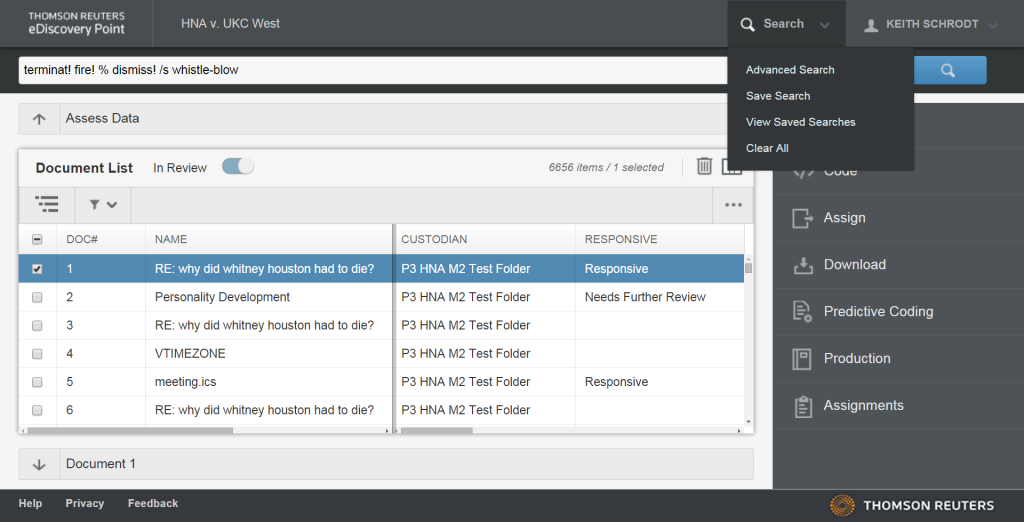
Conducting a search in eDiscovery Point.
At what was billed as an Innovation Summit in its Times Square headquarters yesterday, Thomson Reuters Legal briefed journalists, bloggers and analysts on two products it is unveiling at Legaltech New York next week and also offered tantalizing hints of a product it is developing using the cognitive computing power of IBM’s Watson, the computer that once won Jeopardy!.
The two products it announced were eDiscovery Point, which TR executives positioned as a market-changing platform that is faster and easier to use than other e-discovery products on the market, and Practice Point, a product that straddles two other TR products, Practical Law and Westlaw, and strives to deliver the content from both that is most relevant to a given task or legal issue. There are versions of Practice Point for both law firms and in-house counsel.
[Full disclosure: Thomson Reuters paid for my travel and accommodations to attend the New York City event.]
No Robo Lawyers
With regard to IBM Watson, TR executives provided only crumbs of details. Last October, TR announced that it had entered into a multi-year agreement with IBM to use the Watson technology to develop and enhance products across all its divisions, not just legal. But TR Legal will be the first to release a product that has Watson “under the hood,” according to Eric Laughlin, managing director, Legal Managed Services and Corporate Segment, and head of the Watson Initiative.
The product will help users untangle the sometimes-confusing web of global legal and regulatory requirements and will be targeted at customers in corporate legal, corporate compliance and law firms. Initially, it will focus on financial services, he suggested, but will also address other domains important to corporations.
More details will be released in the second half of this year, he said, when TR will begin rolling out the product to beta users.
“We’re not setting out in the first instance to build robo lawyers,” Laughlin said. “We’re setting out to amplify the intelligence of our clients.”
eDiscovery Point
TR is positioning its new e-discovery platform, eDiscovery Point, as a market-changer that is faster and easier to use than anything else available. It is a web-based platform that TR said was built from the ground up to deliver ease of use, speed and accuracy and sensible pricing.
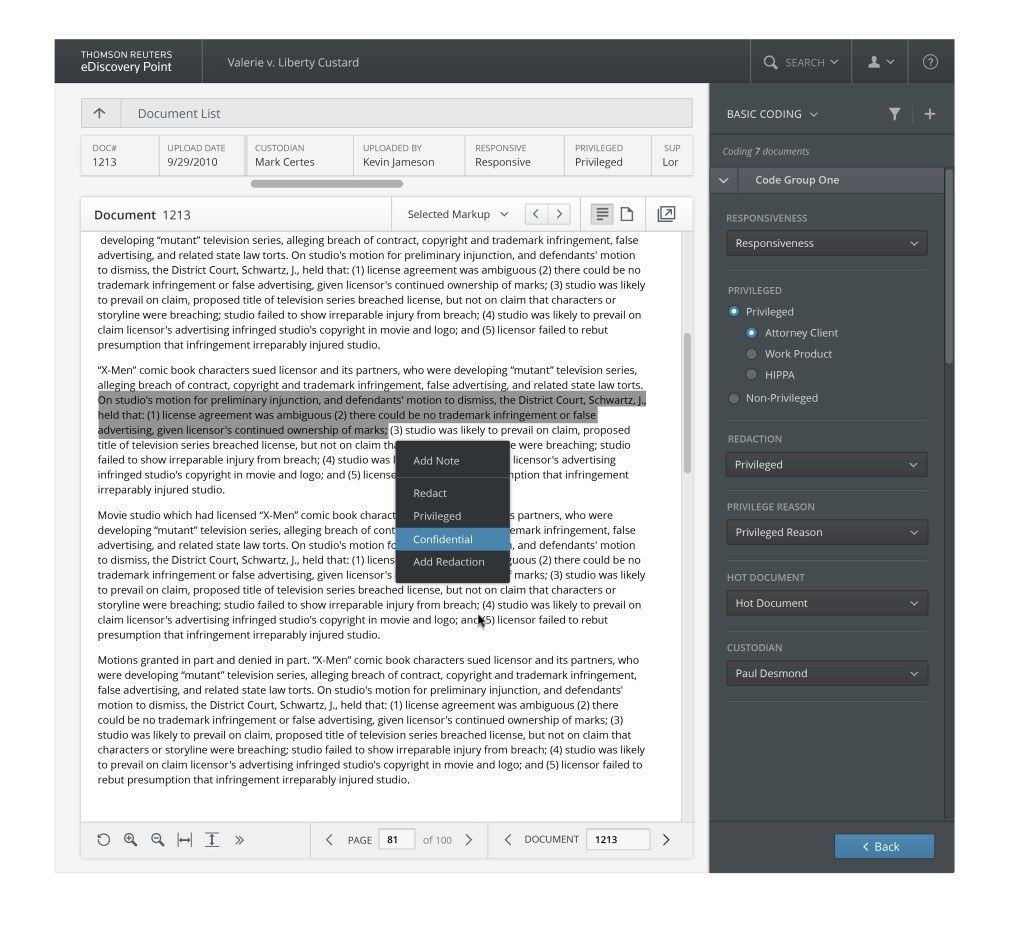
Redacting text during review in eDiscovery Point.
Here is where I have to make another disclosure: I am a paid consultant to another e-discovery vendor, Catalyst. For that reason, I rarely write about e-discovery products and never expressly review other products.
However, I know enough about the market to believe that yesterday’s presentation mischaracterized the state of the market and the uniqueness of TR’s new product. While it is true that some older e-discovery platforms continue to maintain a significant market share, and that those older systems can be hobbled by speed and usability issues, there are also many newer vendors whose products address some or all of these issues in various ways.
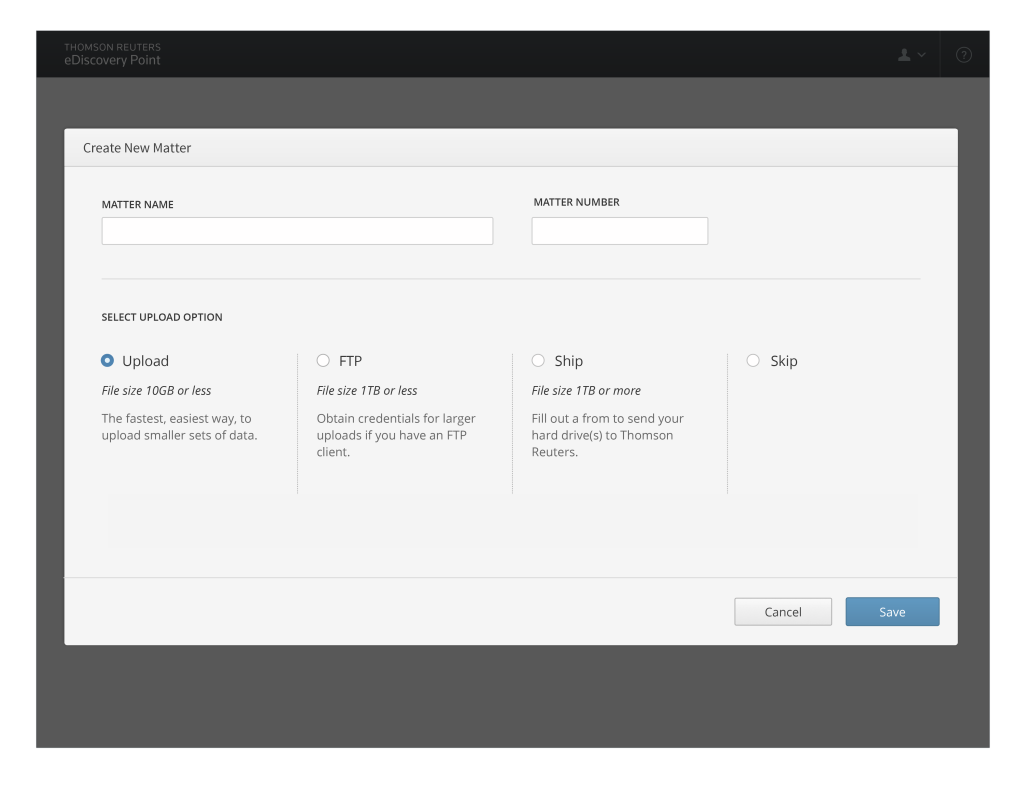
Options for loading files to create a new matter in eDiscovery Point.
The features TR emphasized for eDiscovery Point include fast automated uploading, fast searching for any sized collection, web-based so it works in your browser, an intuitive interface, integrated predictive coding, and fully controllable by the user.
Data ingested into eDiscovery point is converted to HTML5 for indexing. For a search engine, it uses essentially the same engine used by Westlaw. TR claims that searches will be processed in 100 milliseconds. The predictive coding engine is not proprietary to TR but is from Content Analyst.
TR executives said a big goal was to simplify the pricing structure for e-discovery. There will be one price of $40/GB – but that price will only be charged for data that is moved to the review stage. There is no charge for upload processing or for pre-review searching. Only after data is pushed to the review stage do the charges kick in. They will also offer a subscription model with unlimited data in review.
That one price covers:
- Unlimited upload processing and data assessment.
- Predictive coding.
- Production.
- Hosting.
- Dedicated case manager and on-boarding training.
- Physical media handling.
- Technical support
For an additional cost, they will also provide:
- Technical managed services.
- Document review services.
TR said that, in designing the product, it worked closely with four “design partner” law firms: Paul Hastings LLP; Chaffetz Lindsey LLP; Kolesar & Leatham and Munsch Hardt Kopf & Harr, P.C.
Practice Point
Also unveiled yesterday was Practice Point, a research tool designed for transactional lawyers and in-house counsel who are not involved in litigation. Practice Point is somewhat similar in concept to Lexis Practice Advisor (which I first wrote about here) in that it seeks to organize content around specific legal tasks.
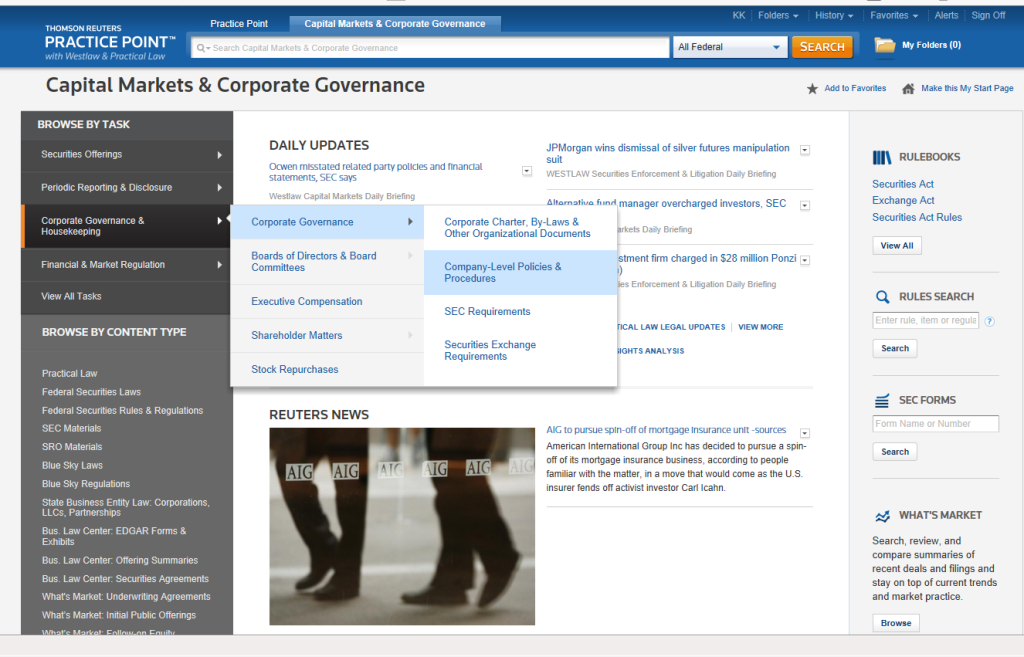
The home page for Capital Markets & Corporate Governance.
Practice Point draws on editor-selected content from both Westlaw and Practical Law and organizes it by practice areas, tasks and projects, with the goal of making it easier for attorneys to find what they need when they need it.
“We’re bringing Practical Law and Westlaw together in a way that transactional lawyers will get the same value out of Westlaw that litigators do,” said Emily Colbert, vice president, Global Workflow Solutions.
To do this, Colbert said, developers and attorney-editors have created a taxonomy that reflects the main tasks these lawyers are doing on a daily basis. The taxonomy is customized to the particular practice area.
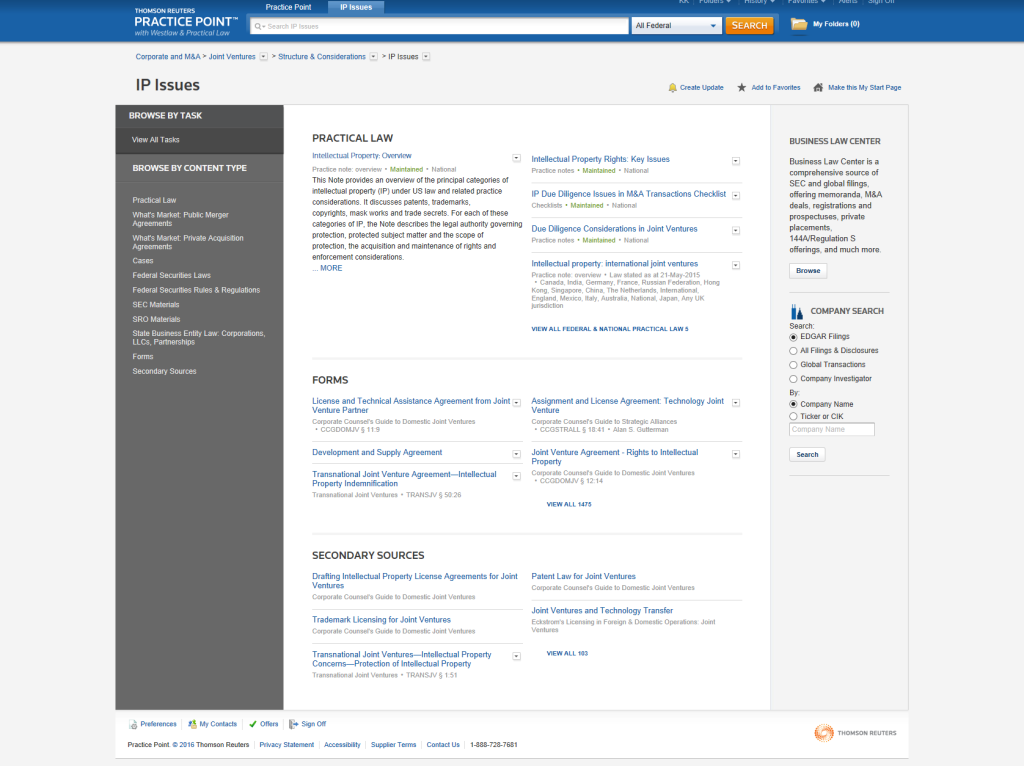
Drilling down through the Corporate and M&A Practice Point.
An M&A attorney, for example, would begin by browsing and selecting from a list of tasks. As a task is selected, specific sets of research sources, forms and secondary sources appear that the editors have determined to be most relevant to that task. Although Practice Point brings certain research tools to the forefront, the entire Westlaw and Practical Law collections are always available.
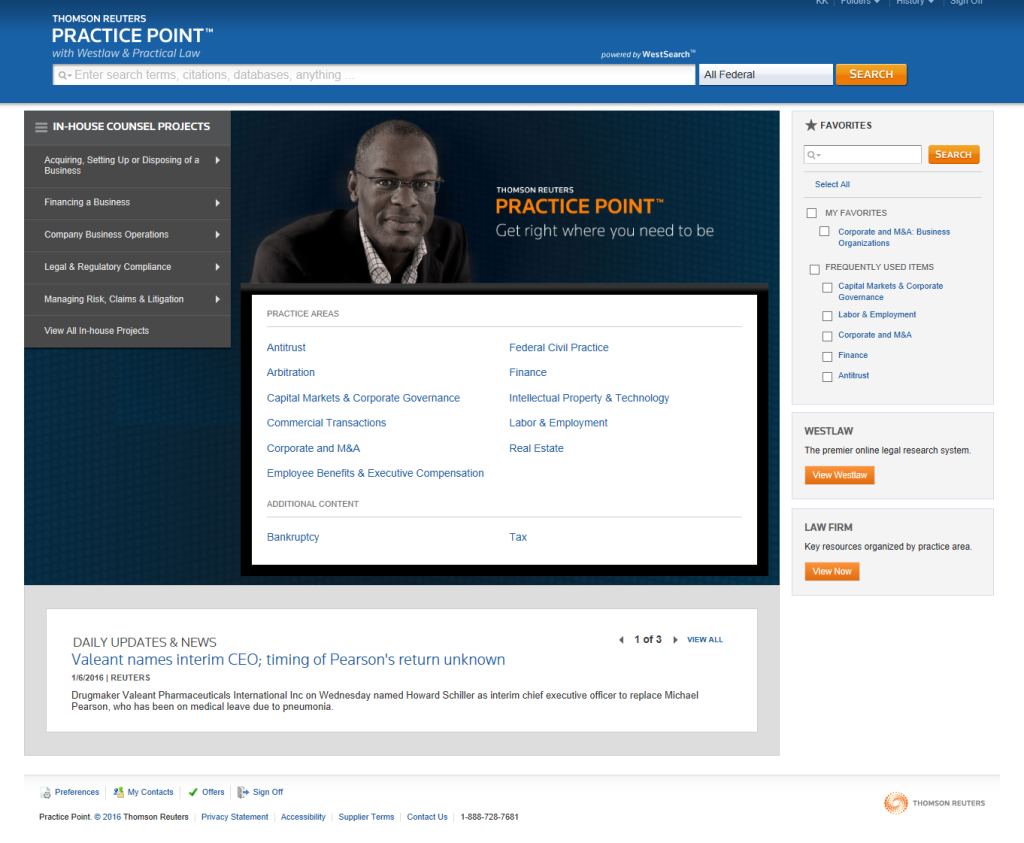
The home page of the in-house version of Practice Point.
Another option is to browse by content types. Here again, the content types that appear are those deemed most relevant to an M&A attorney (or whatever the practice area). Practice Point also displays other available TR tools that are relevant to the task, such as Company Search. At users drill down to more specific levels of tasks, the tools and content types change to reflect the task.
A new tool developed expressly for Practice Point is Rulebooks, an easily searchable collection of key federal laws, rules, regulations and agency materials designed to allow attorneys to pinpoint and track rules and regulations covering securities offerings, SEC disclosures and reporting requirements, proxy solicitation and more.
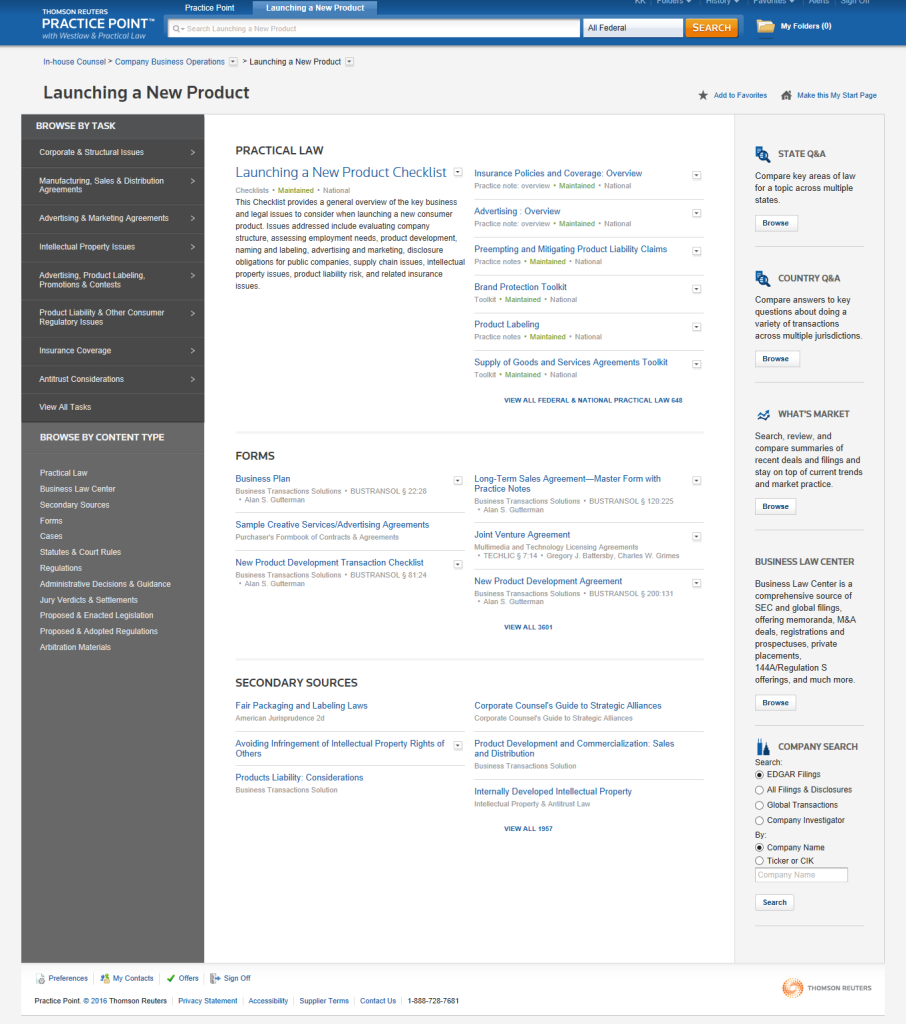
The in-house Practice Point for launching a new product.
There are versions of Practice Point for both private-practice lawyers and in-house counsel, with their own taxonomies, tasks and content.
“All of Practical Law is in Practice Point,” Colbert said. “We’ve tried to organize and curate it so it is most relevant to whatever task you’re doing.”
Future plans for the product include integration with West KM, so that law firm users will also be able to draw on their firm’s own internal documents.
A Focus on Internal Innovation
In comments that opened the day of product announcements, both Susan Taylor Martin, president of TR Legal, and Charlotte Rushton, managing director, U.S. Large Law Firms, and head of innovation, talked about the importance of innovation in the legal industry.
“Technology is changing not just the practice of law, but also the consumption of legal services,” Martin said.
She cited the recent 2016 Georgetown Law-Peer Monitor Report on the State of the Legal Market that analogized law firms to Kodak, the photography giant that closed its eyes to the potential of digital photography and thereby sealed its own fate.
Like Kodak, she said, too many partners at large law firms are holding on to the old ways of practicing law and ignoring the digital future.
Rushton said that TR has in recent years shifted its focus from acquiring innovation to building it internally. Whereas it achieved innovation in the past by acquiring companies such as Pangea 3 and Practical Law, it is now investing much more heavily on encouraging innovation from within.
Three examples she cited are the data and innovation lab it launched last September in Waterloo, Canada, an internal “catalyst fund” that provides funding for innovative employee projects, and recent partnerships with CodeX — The Stanford Center for Legal Informatics — to develop innovative legal technologies.
 Robert Ambrogi Blog
Robert Ambrogi Blog